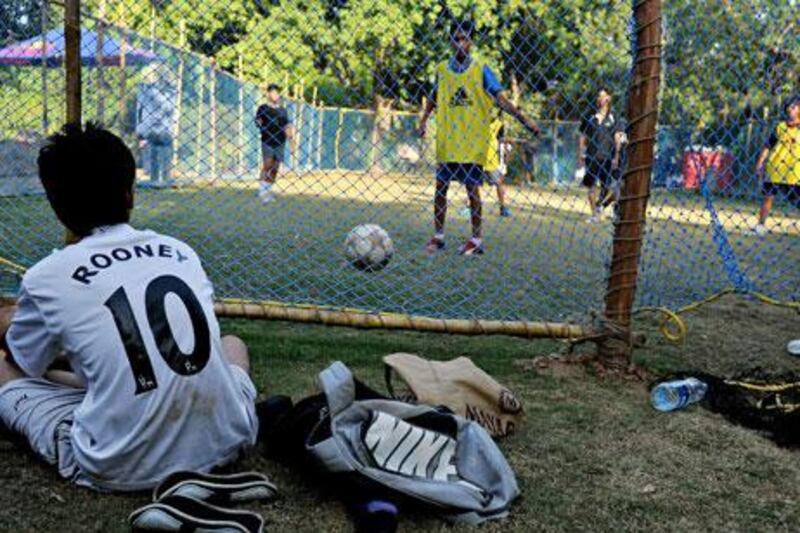When Uefa scheduled the Champions League final for Wembley Stadium, they would have had fantasies about such a match-up - Manchester United, standard-bearers of modern-day English football, against Barcelona, a team capable of otherworldly brilliance.
For millions on the subcontinent as well, this is the dream final. Popular perception paints the region as cricket territory. While there is no doubting that, it should be remembered the number of people in the subcontinent who tune in to the World Cup every four years is more than three times the population of the United Kingdom.
In Lyari Town, Karachi's footballing hotbed, crime levels drop during World Cup month. The streets of Dhaka are divided on colour lines - the sky-blue and white of Argentina on one side, the gold and green of Brazil on the other. In India, the states of West Bengal, Goa and Kerala pretty much come to a halt. In Kerala's Malappuram district, you can even drink a milkshake in your team's colours.
You won't see that fervour tomorrow night, but there will be huge interest, perhaps enough to eclipse the Indian Premier League final in Chennai.
Manchester United, for a variety of reasons, has been the club of choice for hundreds of thousands. Barcelona play the sort of football that fans here cherish, full of trickery and imagination. For those who love both teams, Saturday night will present a dilemma.
While you would be right to view a significant number of the United fans as glory-hunters, there are quite a few whose ties to the club go back more than a generation.
English football was never a big deal in India, post-independence, with little or no newspaper space and radio airtime devoted to it.
That changed 53 years ago when British European Airways Flight 609 crashed on the slick runway at Munich-Riem Airport. The "Busby Babes" who died that day may not have been household names in India, but the nature of the tragedy - talent snuffed out in its prime - struck a chord with millions around the world.
Duncan Edwards epitomised that sense of loss, and though United's fortunes took a sharp turn for the worse in the two decades that followed the famous triumph at Wembley in 1968, those that had become aware of the club during its darkest hour kept the faith.
United red is the third-most popular sporting attire on urban India's streets, after Sachin Tendulkar's India jersey and the Mumbai Indians shirt. To understand why United rate so highly you have to look at how satellite television changed India's sporting landscape.
Even in the early 1990s, the BBC World Service's sports round-up was the only way to follow the fortunes of your club. Then, Rupert Murdoch and ESPN Star Sports came along. By the time Sir Alex Ferguson had had enough of Mark Hughes, Paul "Big Time Charlie" Ince and Andrei Kanchelskis, the wheels were in motion for a television revolution.
When Alan Hansen, no Ferguson fan after being overlooked for Scotland's 1986 World Cup squad, declared that "you'll win nothing with kids", Indians - at least in the major cities - were able to decide for themselves. Many watched that David Beckham goal against Wimbledon and the success of a young and vibrant team in England and Europe earned for them the patronage of a new generation.
But India and English football are not an easy fit. The up-and-at-'em style favoured by the likes of Howard Wilkinson, Sam Allardyce and Tony Pulis makes most fans recoil in horror. They want someone who can dribble like Diego Maradona, pass like Xavi and boss a game like Zinedine Zidane in his prime. Go to any little space where football is played and the emphasis is on skill - often mistaken for over-elaboration - rather than strength and speed.
It is not a philosophy that has served Indian football well; the national team has done nothing of note since the 1960s.
But the enduring obsession with Brazil and Argentina makes it evident which style of football the fans embrace.
The fondness for Barcelona goes beyond skill, though. It also goes beyond the academy the club has set up in Andhra Pradesh's Anantpur district to help underprivileged children. As much as people admire Xavi and Andres Iniesta, Barcelona's following is largely down to one man with a build so slight he could be an urchin playing on a beach in Goa or a paddy field in Kerala.
Lionel Messi has captured the Indian imagination like no player apart from Maradona has ever done.
If he does play when the Albiceleste visit Kolkata in September, they could sell out the 100,000-seat stadium many times over.
On Saturday, most of the aficionados will have to decide: do they go for the team that Ferguson has built, or for the player whose skill bedazzles them?
Champions League coverage, s4-8





